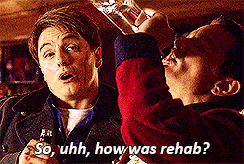Just saw this scene for the first time, and I was actually moved to tears by it - it profoundly affected me, and got into me and affected me under my skin so much, I just found myself totally overwhelmed with a spontaneous rush of emotional intensity.
“To say it again: There is VERY LITTLE DIFFERENCE between The Capacity for Mayhem and Destruction, INTEGRATED, and Strength of Character.
This is one of the most difficult lessons of life.
Maybe you are a loser.
And maybe you’re not—
but if you are, you don’t have to continue in that mode.
Maybe you just have a bad habit.
Maybe you’re even just a collection of bad habits.
Nonetheless, even if you came by your poor posture honestly—even if you were unpopular or bullied at home or in grade school — it’s not necessarily appropriate now.
Circumstances change.
If you slump around, with the same bearing that characterizes a defeated lobster, people will assign you a lower status, and the old counter that you share with crustaceans, sitting at the very base of your brain, will assign you a low dominance number.
Then your brain will not produce as much serotonin. This will make you less happy, and more anxious and sad, and more likely to back down when you should stand up for yourself.
It will also decrease the probability that you will get to live in a good neighbourhood, have access to the highest quality resources, and obtain a healthy, desirable mate.
It will render you more likely to abuse cocaine and alcohol, as you live for the present in a world full of uncertain futures.
It will increase your susceptibility to heart disease, cancer and dementia. All in all, it’s just not good. Circumstances change, and so can you. Positive feedback loops, adding effect to effect, can spiral counterproductively in a negative direction, but can also work to get you ahead. That’s the other, far more optimistic lesson of Price’s law and the Pareto distribution: those who start to have will probably get more. Some of these upwardly moving loops can occur in your own private, subjective space. Alterations in body language offer an important example. If you are asked by a researcher to move your facial muscles, one at a time, into a position that would look sad to an observer, you will report feeling sadder. If you are asked to move the muscles one by one into a position that looks happy, you will report feeling happier. Emotion is partly bodily expression, and can be amplified (or dampened) by that expression. 29 Some of the positive feedback loops instantiated by body language can occur beyond the private confines of subjective experience, in the social space you share with other people. If your posture is poor, for example—if you slump, shoulders forward and rounded, chest tucked in, head down, looking small, defeated and ineffectual (protected, in theory, against attack from behind)—then you will feel small, defeated and ineffectual. The reactions of others will amplify that. People, like lobsters, size each other up, partly in consequence of stance. If you present yourself as defeated, then people will react to you as if you are losing. If you start to straighten up, then people will look at and treat you differently. You might object: the bottom is real. Being at the bottom is equally real. A mere transformation of posture is insufficient to change anything that fixed. If you’re in number ten position, then standing up straight and appearing dominant might only attract the attention of those who want, once again, to put you down. And fair enough. But standing up straight with your shoulders back is not something that is only physical, because you’re not only a body. You’re a spirit, so to speak—a psyche—as well. Standing up physically also implies and invokes and demands standing up metaphysically. Standing up means voluntarily accepting the burden of Being. Your nervous system responds in an entirely different manner when you face the demands of life voluntarily. You respond to a challenge, instead of bracing for a catastrophe. You see the gold the dragon hoards, instead of shrinking in terror from the all-too-real fact of the dragon. You step forward to take your place in the dominance hierarchy, and occupy your territory, manifesting your willingness to defend, expand and transform it. That can all occur practically or symbolically, as a physical or as a conceptual restructuring. To stand up straight with your shoulders back is to accept the terrible responsibility of life, with eyes wide open. It means deciding to voluntarily transform the chaos of potential into the realities of habitable order. It means adopting the burden of self-conscious vulnerability, and accepting the end of the unconscious paradise of childhood, where finitude and mortality are only dimly comprehended. It means willingly undertaking the sacrifices necessary to generate a productive and meaningful reality (it means acting to please God, in the ancient language). To stand up straight with your shoulders back means building the ark that protects the world from the flood, guiding your people through the desert after they have escaped tyranny, making your way away from comfortable home and country, and speaking the prophetic word to those who ignore the widows and children. It means shouldering the cross that marks the X, the place where you and Being intersect so terribly. It means casting dead, rigid and too tyrannical order back into the chaos in which it was generated; it means withstanding the ensuing uncertainty, and establishing, in consequence, a better, more meaningful and more productive order. So, attend carefully to your posture. Quit drooping and hunching around. Speak your mind. Put your desires forward, as if you had a right to them—at least the same right as others. Walk tall and gaze forthrightly ahead. Dare to be dangerous. Encourage the serotonin to flow plentifully through the neural pathways desperate for its calming influence. People, including yourself, will start to assume that you are competent and able (or at least they will not immediately conclude the reverse). Emboldened by the positive responses you are now receiving, you will begin to be less anxious. You will then find it easier to pay attention to the subtle social clues that people exchange when they are communicating. Your conversations will flow better, with fewer awkward pauses. This will make you more likely to meet people, interact with them, and impress them. Doing so will not only genuinely increase the probability that good things will happen to you—it will also make those good things feel better when they do happen. Thus strengthened and emboldened, you may choose to embrace Being, and work for its furtherance and improvement. Thus strengthened, you may be able to stand, even during the illness of a loved one, even during the death of a parent, and allow others to find strength alongside you when they would otherwise be overwhelmed with despair. Thus emboldened, you will embark on the voyage of your life, let your light shine, so to speak, on the heavenly hill, and pursue your rightful destiny. Then the meaning of your life may be sufficient to keep the corrupting influence of mortal despair at bay. Then you may be able to accept the terrible burden of the World, and find joy. Look for your inspiration to the victorious lobster, with its 350 million years of practical wisdom. Stand up straight, with your shoulders back.

